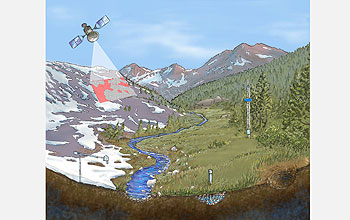|

Press Release 07-178
NSF Awards Grants for Three Critical Zone Observatories

New "holistic" Earth surface observatories to focus on the science of watershed evolution
November 26, 2007
The National Science Foundation (NSF) has selected sites for three critical zone observatories (CZO). The observatories are designed to provide scientists with an understanding of what has come to be called the critical zone--the region between the top of the forest canopy and the base of unweathered rock: our living environment--and its response to climate and land use changes. The CZOs represent the first set of systems-based observatories dedicated to Earth surface processes. Scientists at each CZO will investigate the integration and coupling of Earth surface processes and how they are affected by the presence and flux of fresh water. The CZOs will use field and analytical research methods, space-based remote sensing and theoretical techniques. The three CZOs are located in watersheds in the Sierra Nevada, the Front Range of the Colorado Rockies, and the Appalachian Uplands. The respective awardees are the University of California at Merced, the University of Colorado at Boulder, and Pennsylvania State University. These projects add to the environmental sensor networks in place and planned by NSF, including EarthScope, the National Ecological Observatory Network, and the Ocean Observatories Network. "Scientists have known for a long time that the critical zone is a complex system in which the different components interact at various space and time scales and in which the rates of processes depend on the nature of the interactions," said Art Goldstein, director of NSF's division of earth sciences, which funded the CZOs. "Until now, we have looked at these components individually, particularly in the field. The CZOs are a very exciting development that will allow for investigation of the critical zone as a holistic system, rather than as isolated parts of a system." The water cycle, the break-down of rocks and formation of soil, the geochemical and physical erosion of that soil, evolution of rivers and valleys, patterns of vegetation, and the form and function of the Earth that we see are products of multiple, highly interactive processes in the critical zone. "The water, vegetation and geochemistry are all interrelated, with feedbacks from each influencing the others," said scientist Roger Bales of UC Merced/the Sierra Nevada CZO. Society has long recognized the importance of water, soil, land forms and rivers to human welfare, but has only recently begun to holistically probe the workings of these coupled systems, he and other researchers believe. Suzanne Anderson of the Colorado CZO said that "the observatories will benefit our comprehension of the entire Earth surface by spurring more connection of individual research to larger questions. The CZOs mark a significant change in the way we study the surface of the Earth." Chris Duffy of Pennsylvania State University-led Susquehanna/Shale Hills CZO said that the research "will lead to a predictive understanding of how changing climate and human activities impact the evolution and function of the critical zone, especially as it relates to sustainable water resources." How hydrologic, physical, geochemical, and biological processes interact to break-down rocks, to form soil and to shape the landscape are significant questions in many earth science--and societal--problems, said Goldstein. Scientists at NSF's new CZOs are working to find answers to these questions: - How do landscapes evolve over both human generational time scales and over multi-millennia, and how is this process affected by the presence and flow of water?
- How do soil and weathered bedrock move down hillslopes, and how are they coupled to the evolution of the channel that usually surrounds the base of the hillslopes?
- How do biological processes impact physical processes?
- Are there signals in the landscape that can tell us about past climates, about how these landscapes have responded--and might in the future--to climate change?
-NSF-

Media Contacts
Cheryl Dybas, NSF (703) 292-7734 cdybas@nsf.gov

The National Science Foundation (NSF) is an independent federal agency that supports fundamental research and education across all fields of science and engineering. In fiscal year (FY) 2009, its budget is $9.5 billion, which includes $3.0 billion provided through the American Recovery and Reinvestment Act. NSF funds reach all 50 states through grants to over 1,900 universities and institutions. Each year, NSF receives about 44,400 competitive requests for funding, and makes over 11,500 new funding awards. NSF also awards over $400 million in professional and service contracts yearly.
 Get News Updates by Email Get News Updates by Email
Useful NSF Web Sites:
NSF Home Page: http://www.nsf.gov
NSF News: http://www.nsf.gov/news/
For the News Media: http://www.nsf.gov/news/newsroom.jsp
Science and Engineering Statistics: http://www.nsf.gov/statistics/
Awards Searches: http://www.nsf.gov/awardsearch/
| 

